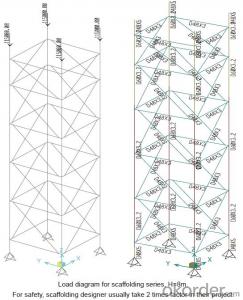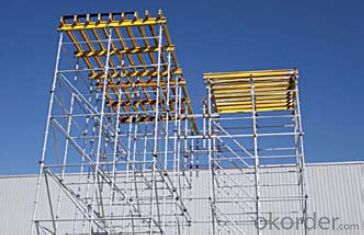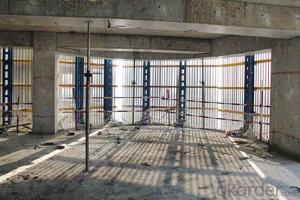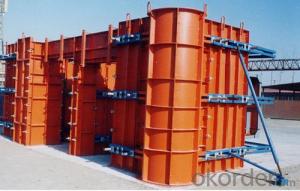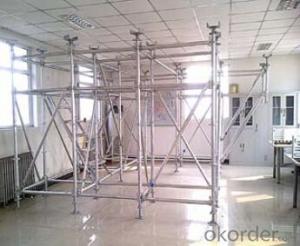Ringlock Scaffolding accessories for formwork and scaffolding system
- Loading Port:
- Tianjin
- Payment Terms:
- TT OR LC
- Min Order Qty:
- 50 m²
- Supply Capability:
- 1000 m²/month
OKorder Service Pledge
Quality Product, Order Online Tracking, Timely Delivery
OKorder Financial Service
Credit Rating, Credit Services, Credit Purchasing
You Might Also Like
Ring-lock Scaffolding
A support system for construction, ownsadvantages of both cup-lock scaffolding andshoring tower.
It is in the development direction of new typescaffolding.
It is widely used in buildings, bridges, tunnels etc..
Characteristics:
◆ Easy to storage and transportation
◆ High degree of standardization
◆ Easy and quick erection
◆ Excellent stability and bearing capacity
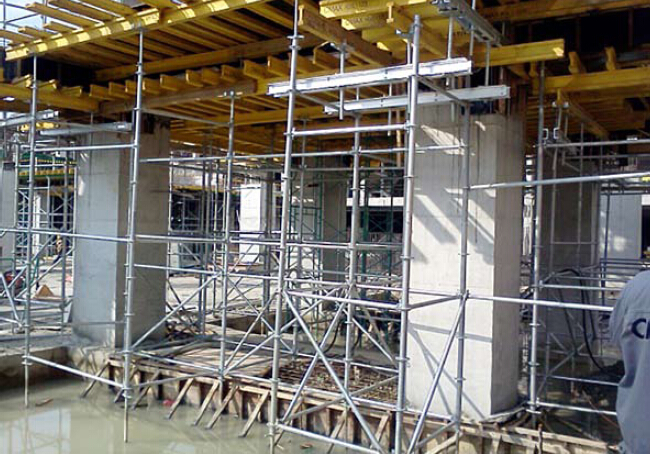
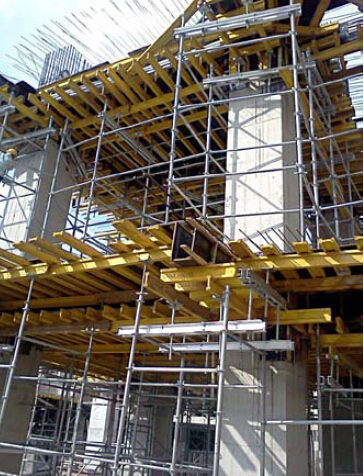
- Q: Can steel formwork be used for tunnel construction projects?
- Yes, steel formwork can be used for tunnel construction projects. Steel formwork is highly durable and can withstand the pressure and forces exerted during tunnel construction. It provides a strong and stable structure for pouring concrete and creating the tunnel walls. Steel formwork is also reusable, making it a cost-effective option for tunnel construction projects. Additionally, steel formwork can be easily customized to meet the specific requirements of the tunnel design, allowing for efficient and precise construction. Overall, steel formwork is a suitable choice for tunnel construction projects due to its strength, durability, and flexibility.
- Q: How does steel formwork contribute to the construction process?
- Steel formwork is a crucial component in the construction process as it plays a significant role in shaping and supporting concrete structures. It is used for forming walls, columns, beams, and slabs, providing the necessary support during the pouring and curing of concrete. One major contribution of steel formwork is its strength and durability. Steel is known for its high tensile strength, which allows it to withstand the pressure exerted by the weight of the concrete. This strength ensures that the formwork remains intact and stable, preventing any deformation or collapse during the construction process. Additionally, steel formwork is highly versatile and can be customized to any desired shape or size. This flexibility enables architects and engineers to create complex and unique structures that would be difficult to achieve with other formwork materials. The ability to shape the formwork according to specific design requirements ensures that the final concrete structure is not only functional but also aesthetically pleasing. Moreover, steel formwork offers excellent reusability. Unlike other formwork materials such as wood or plywood, steel formwork can be reused multiple times without compromising its structural integrity. This reusability factor not only reduces construction costs but also minimizes waste and promotes sustainability in the construction industry. Another advantage of steel formwork is its ease of assembly and disassembly. It can be quickly installed and dismantled, allowing for faster construction cycles. This efficiency saves time and labor, leading to increased productivity and overall cost savings on construction projects. Furthermore, steel formwork provides a smooth and consistent finish to the concrete surface. The steel panels are designed to be impermeable, preventing any leakage or seepage of concrete. This feature ensures that the concrete cures uniformly, resulting in a high-quality finish that meets the desired specifications. In conclusion, steel formwork significantly contributes to the construction process by providing strength, durability, versatility, reusability, ease of assembly, and a smooth finish to concrete structures. Its essential role in shaping and supporting concrete elements makes it an indispensable tool for modern construction projects.
- Q: Can steel formwork be used for both horizontal and vertical concrete placement?
- Yes, steel formwork can be used for both horizontal and vertical concrete placement. Steel formwork is a versatile and durable solution for creating molds or frames that hold wet concrete in the desired shape until it sets and hardens. This type of formwork is commonly used in construction projects for various applications, including both horizontal and vertical concrete placement. Steel forms are strong enough to withstand the weight and pressure of the concrete, making them suitable for vertical applications such as walls, columns, and beams. Additionally, steel formwork can be easily adjusted or modified to accommodate different shapes and sizes, making it ideal for horizontal placements like slabs, floors, and pavement. Overall, steel formwork offers flexibility, strength, and stability, making it suitable for a wide range of concrete placement requirements.
- Q: What are the challenges of using steel formwork?
- Using steel formwork in construction projects presents a number of challenges. Firstly, the cost of steel formwork is considerably higher compared to alternative options like timber or aluminum. This initial expense can discourage contractors, especially those working with limited budgets on smaller projects. Secondly, the weight of steel formwork is greater than that of other formwork materials, making it more challenging to handle and transport on the construction site. This can result in increased labor costs and slower progress. A further challenge is the inflexibility of steel formwork. Unlike timber formwork, which can be easily cut and shaped to suit specific project requirements, steel formwork is rigid and less adaptable. This can pose difficulties when working on complex or irregular structures. Moreover, the installation and dismantling of steel formwork require skilled labor and expertise. Inexperienced workers may struggle with the process, leading to potential safety risks and inefficiencies. Lastly, regular maintenance is essential to prevent rust and ensure the longevity of steel formwork. Exposure to weather conditions and concrete over time can cause corrosion, compromising the structural integrity. This maintenance work adds both time and cost to the construction project. Despite these challenges, steel formwork still offers advantages such as strength, durability, and reusability. It provides a smooth surface finish for concrete and can withstand high pressure loads. Ultimately, the decision to use steel formwork depends on the specific requirements, budget, and expertise available for the construction project.
- Q: Can steel formwork be used for projects with limited formwork transportation options?
- Yes, steel formwork can be used for projects with limited formwork transportation options. Steel formwork is known for its durability, strength, and reusability, making it an ideal choice for projects that require transportation over long distances or difficult terrains. Unlike traditional wood formwork, steel formwork can withstand the rigors of transportation without getting damaged or deformed. Furthermore, steel formwork is lightweight compared to other materials used for formwork, such as concrete or timber, which makes it easier to transport even in areas with limited transportation options. The lightweight nature of steel formwork not only reduces transportation costs but also allows for easier handling and installation on-site. Additionally, steel formwork can be easily disassembled and reassembled, making it suitable for projects that require frequent formwork transportation. The modular design of steel formwork allows for easy transportation and reconfiguration, ensuring that the formwork can be efficiently transported to different project sites as needed. In conclusion, steel formwork is a versatile and practical solution for projects with limited formwork transportation options. Its durability, lightweight nature, and ease of disassembly and reassembly make it a suitable choice for projects that require formwork to be transported over long distances or difficult terrains.
- Q: What are the considerations when selecting the appropriate steel grade for formwork?
- When selecting the appropriate steel grade for formwork, there are several considerations that need to be taken into account. Firstly, the load-bearing capacity of the steel grade is of utmost importance. The steel should be able to withstand the weight and pressure exerted by the concrete and any additional loads that may be applied during construction. It should be able to maintain its structural integrity without any deformation or failure. Secondly, the corrosion resistance of the steel grade is crucial. As formwork is often subjected to moisture and chemicals present in concrete, it is essential to choose a steel grade that can resist corrosion. This will ensure the longevity and durability of the formwork, avoiding any potential safety hazards or costly repairs. Another consideration is the ease of handling and fabrication. The selected steel grade should be easy to cut, shape, and weld, allowing for efficient and accurate construction of formwork. It should also have good dimensional stability, ensuring that the formwork remains in the desired shape and size during use. The cost-effectiveness of the steel grade is also a significant factor. While it may be tempting to opt for a higher grade steel with superior properties, it is essential to evaluate the project requirements and choose a grade that offers the necessary performance at a reasonable cost. This will help to optimize the budget without compromising on the quality and functionality of the formwork. Lastly, compliance with industry standards and regulations should be considered. The selected steel grade should meet the relevant codes and specifications set by governing bodies to ensure that the formwork meets safety standards and can withstand the intended loads and environmental conditions. By taking these considerations into account, one can select an appropriate steel grade for formwork that ensures structural stability, durability, corrosion resistance, ease of handling, cost-effectiveness, and compliance with industry standards.
- Q: Are there any weight restrictions for transporting steel formwork?
- Yes, there are typically weight restrictions for transporting steel formwork. The specific weight restrictions can vary depending on the type of transportation method being used, such as trucks, cranes, or forklifts. It is important to adhere to these restrictions to ensure the safety of the transportation process and to prevent any damage to the formwork or the vehicle being used. Additionally, exceeding weight restrictions can also result in legal consequences, such as fines or penalties. Therefore, it is crucial to consult the relevant transportation guidelines and regulations to determine the specific weight restrictions for transporting steel formwork.
- Q: Can steel formwork be used for single-sided formwork applications?
- Yes, steel formwork can be used for single-sided formwork applications. Steel formwork is known for its strength and durability, making it suitable for various construction applications, including single-sided formwork. It provides excellent support and stability to the concrete during pouring and curing processes, ensuring a smooth and efficient construction process.
- Q: Can steel formwork be used for precast concrete balconies?
- Yes, steel formwork can be used for precast concrete balconies. Steel formwork offers durability, strength, and stability, making it a suitable option for constructing precast concrete balconies. It provides a smooth finish to the concrete surface and allows for easy demolding and reusability, increasing efficiency in the construction process.
- Q: What are the different types of edge protection systems used in steel formwork?
- There are several types of edge protection systems that are commonly used in steel formwork to ensure the safety of workers and prevent accidents. These systems are designed to provide a secure barrier along the edges of the formwork, preventing falls and providing support for workers. Some of the different types of edge protection systems used in steel formwork include: 1. Handrails: Handrails are one of the most common types of edge protection systems used in steel formwork. They consist of a horizontal bar that is placed at a certain height along the edge of the formwork to provide a stable support for workers. Handrails are typically made of steel or other durable materials and are designed to withstand heavy loads and provide a secure grip for workers. 2. Toeboards: Toeboards are another type of edge protection system used in steel formwork. They are placed along the lower edge of the formwork to prevent objects or materials from falling off and causing accidents. Toeboards are typically made of steel or other sturdy materials and are designed to withstand impact and provide a solid barrier. 3. Mesh barriers: Mesh barriers are frequently used as edge protection systems in steel formwork. They consist of a flexible mesh that is attached to the formwork to create a barrier that prevents falls and provides a visual warning for workers. Mesh barriers are typically made of high-strength materials such as steel wire or polypropylene and are designed to be durable and resistant to impact. 4. Safety nets: Safety nets are another type of edge protection system used in steel formwork. They are typically suspended below the formwork to catch workers or objects in case of a fall. Safety nets are made of strong and flexible materials and are designed to absorb the impact of a fall and prevent serious injuries. 5. Guardrails: Guardrails are commonly used as edge protection systems in steel formwork. They consist of a vertical post and a horizontal rail that are placed along the edges of the formwork to provide a solid barrier. Guardrails are typically made of steel or other strong materials and are designed to withstand heavy loads and provide a secure barrier for workers. Overall, the different types of edge protection systems used in steel formwork are designed to provide a safe working environment for workers and prevent accidents. These systems play a crucial role in ensuring the safety and well-being of workers in construction sites.
Send your message to us
Ringlock Scaffolding accessories for formwork and scaffolding system
- Loading Port:
- Tianjin
- Payment Terms:
- TT OR LC
- Min Order Qty:
- 50 m²
- Supply Capability:
- 1000 m²/month
OKorder Service Pledge
Quality Product, Order Online Tracking, Timely Delivery
OKorder Financial Service
Credit Rating, Credit Services, Credit Purchasing
Similar products
Hot products
Hot Searches
Related keywords

